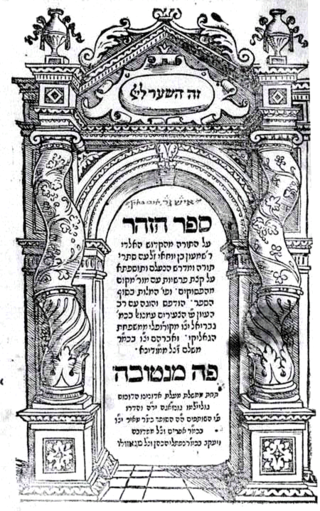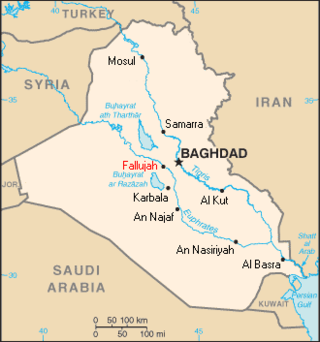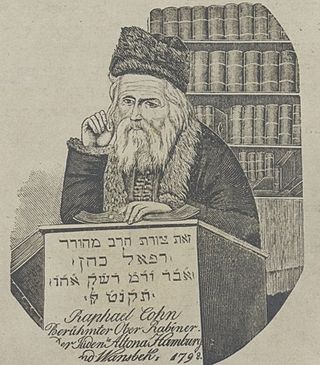Related Research Articles

The Zohar is a foundational work of Kabbalistic literature. It is a group of books including commentary on the mystical aspects of the Torah and scriptural interpretations as well as material on mysticism, mythical cosmogony, and mystical psychology. The Zohar contains discussions of the nature of God, the origin and structure of the universe, the nature of souls, redemption, the relationship of Ego to Darkness and "true self" to "The Light of God".

Abraham ben Meir Ibn Ezra was one of the most distinguished Jewish biblical commentators and philosophers of the Middle Ages. He was born in Tudela, Taifa of Zaragoza.
According to Jewish tradition, the Torah contains 613 commandments. This tradition is first recorded in the 3rd century CE, when Rabbi Simlai mentioned it in a sermon that is recorded in Talmud Makkot 23b. Other classical sages who hold this view include Rabbi Simeon ben Azzai and Rabbi Eleazar ben Yose the Galilean. It is quoted in Midrash Exodus Rabbah 33:7, Numbers Rabbah 13:15–16; 18:21 and Talmud Yevamot 47b. The 613 commandments include "positive commandments", to perform an act, and "negative commandments", to abstain from an act. The negative commandments number 365, which coincides with the number of days in the solar year, and the positive commandments number 248, a number ascribed to the number of bones and main organs in the human body.

Hai ben Sherira better known as Hai Gaon, was a medieval Jewish theologian, rabbi and scholar who served as Gaon of the Talmudic academy of Pumbedita during the early 11th century. He was born in 939 and died on March 28, 1038. He received his Talmudic education from his father, Sherira ben Hanina, and in early life acted as his assistant in teaching. In his forty-fourth year he became associated with his father as "av bet din," and with him delivered many joint decisions. According to Sefer HaKabbalah of Rabbi Abraham ben David (Ravad), he was the last of the Geonim.
Eleazar of Worms, or Eleazar ben Judah ben Kalonymus, also sometimes known today as Eleazar Rokeach from the title of his Book of the Perfumer —where the numerical value of "Perfumer" is equal to Eleazar, was a leading Talmudist and Kabbalist, and the last major member of the Hasidei Ashkenaz, a group of German Jewish pietists.

Tzadik is a title in Judaism given to people considered righteous, such as biblical figures and later spiritual masters. The root of the word ṣadiq, is ṣ-d-q, which means "justice" or "righteousness". When applied to a righteous woman, the term is inflected as tzadika/tzaddikot.
Israel ben Moses Najara was a prolific Jewish liturgical poet, preacher, Biblical commentator, kabbalist, and rabbi of Gaza.
Mordecai ben Avraham Yoffe was a Rabbi, Rosh yeshiva and posek. He is best known as author of Levush Malkhus, a ten-volume codification of Jewish law that particularly stressed the customs of the Jews of Eastern Europe. He is known as "the Levush" or "the Ba'al Halevushim", for this work.

Isaiah or Yeshayahu ben Avraham Ha-Levi Horowitz, , also known as the Shelah HaKaddosh after the title of his best-known work, was a prominent rabbi and mystic.
Moshe haDarshan was chief of the yeshiva of Narbonne, and perhaps the founder of Jewish exegetical studies in France. Along with Rashi, his writings are often cited as the first extant writings in Zarphatic, the Judæo-French language.
Abraham ben Abraham, also known as Count Valentine Potocki, was a purported Polish nobleman (szlachta) of the Potocki family who converted to Judaism and was burned at the stake by the Roman Catholic Church because he had renounced Catholicism and had become an observant Jew. According to Jewish oral traditions, he was known to the revered Talmudic sage, the Vilna Gaon, and his ashes were interred in the relocated grave of the Vilna Gaon in Vilna's new Jewish cemetery.
Isaac Israeli ben Joseph or Yitzhak ben Yosef was a Spanish-Jewish astronomer/astrologer who flourished at Toledo in the first half of the fourteenth century.
Abraham Lichtstein was a Polish rabbi and Talmudist. He served as the Av Beis Din of Przasnysz, Poland and authored a commentary on the Pentateuch entitled Kanfei Nesharim.
Isaiah di Trani ben Mali (the Elder) (c. 1180 – c. 1250) (Hebrew: ישעיה בן מאלי הזקן דטראני), better known as the RID, was a prominent Italian Talmudist.
Moses ben Mordecai Zacuto, also known by the Hebrew acronym RaMa"Z, was a rabbi, Kabbalist, and poet. Zacuto, who was born into a Portuguese Marrano family in Amsterdam, studied Jewish subjects under Saul Levi Morteira. He also studied secular subjects, such as the Latin language. As a pupil of Morteira, he may also have been, as a youth still in Amsterdam, a fellow student of Baruch Spinoza.
Joseph ben Samuel Bonfils was a French rabbi, Talmudist, Bible commentator, and payyetan of the mid-eleventh century. He is also known by the Hebrew name Yosef Tov Elem, a Hebrew translation from the French name "Bonfils."
Isaac David Broydé was an Orientalist and librarian.

Rabbi Raphael ben Jekuthiel Susskind Cohen, in German Rafael ben Jekutiel Süsskind Kohen, a kohen, was Chief Rabbi of Altona-Hamburg-Wandsbek from 1775.
Aaron HaLevi ben Moses (Hurwitz) of Staroselye was a Talmudic scholar and Kabbalist of note who lived in Poland during the latter part of the eighteenth century and the early part of the nineteenth.
Israel ben Moses ha-Levi Zamosz was an eighteenth-century Talmudist, mathematician and poet.
References
- ↑ יסוד ושורש העבודה [Yesod we-Shoresh ha-'Abodah] (in Hebrew). Novydvor: JAK. Retrieved May 14, 2015.
- ↑ צוואה [Will] (in Hebrew). Grodno. Retrieved May 14, 2015.
- ↑
 This article incorporates text from a publication now in the public domain : Singer, Isidore; et al., eds. (1901–1906). "ALEXANDER SÜSSKIND BEN MOSES OF GRODNO". The Jewish Encyclopedia . New York: Funk & Wagnalls. Retrieved May 14, 2015.
This article incorporates text from a publication now in the public domain : Singer, Isidore; et al., eds. (1901–1906). "ALEXANDER SÜSSKIND BEN MOSES OF GRODNO". The Jewish Encyclopedia . New York: Funk & Wagnalls. Retrieved May 14, 2015.
Jewish Encyclopedia bibliography: